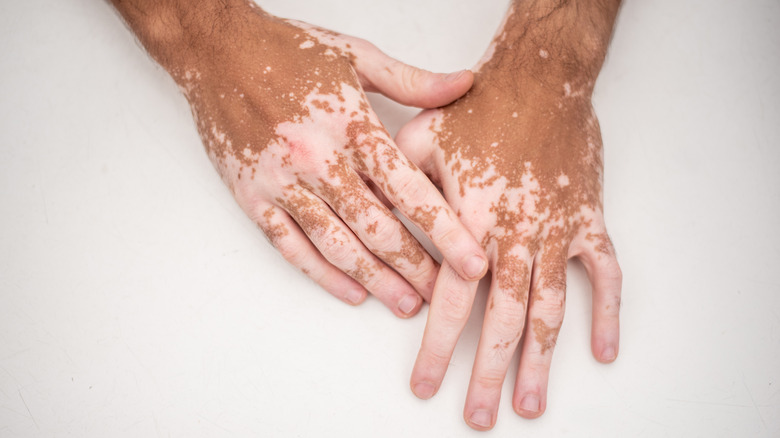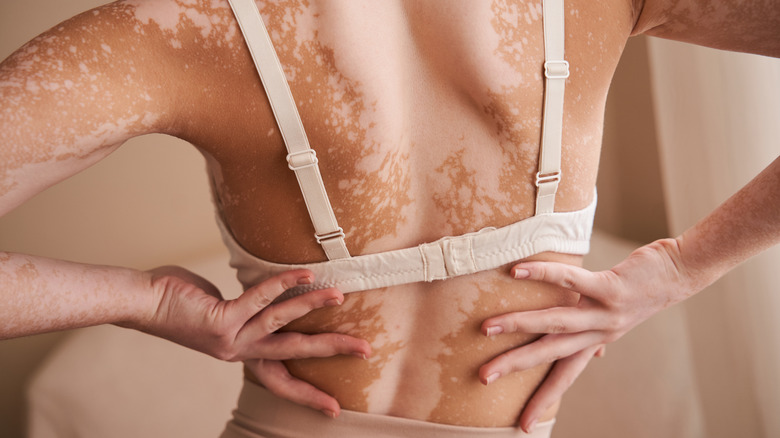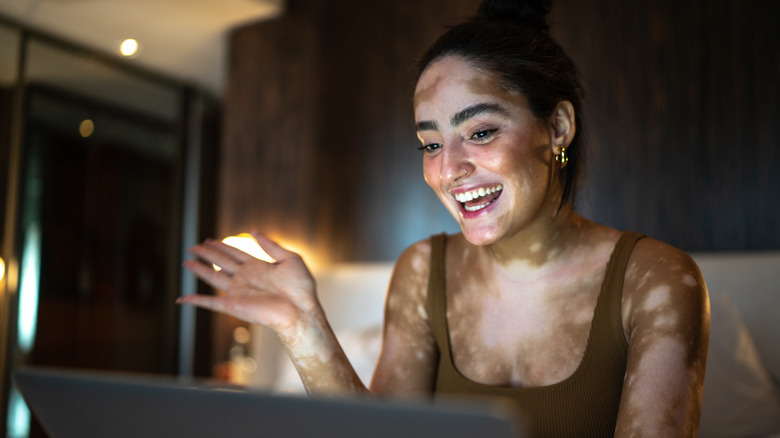There's Much More To Vitiligo Than You May Know
Our understanding of skin conditions is often surface-level. When it comes to representation in the beauty and wellness world, there's little effort being made to be inclusive of all skin types and conditions — like Vitiligo. Vitiligo is a skin condition that causes loss of skin color, typically in patches. These discolorations grow with time and can spread across the body, the color of which is determined by melanin. Although there have been recent treatment methods, like algae as a skincare superhero, the conversation surrounding Vitiligo is not informative enough. We're here to clear things up.
Vitiligo typically begins with a number of light patches, or discoloration of skin. While it often starts at the hands, it can spread to the mouth, nose, and even genital areas. It is often more harmful to folks who have autoimmune conditions, such as anemia, diabetes, and psoriasis. These conditions make our immune systems weaker in developing and maintaining melanocytes — skin cells that produce melanin. Although vitiligo affects over 1% of the world's population, its lack of representation and research leaves those with the condition at a loss for information.
Different kinds of vitiligo
There are a few different kinds of vitiligo conditions that vary in appearance, development, and placement. Generalized vitiligo is the most common type of vitiligo, where discoloration, or macules, appear on different parts of the body. For more specific conditions — like segmental, mucosal, focal, trichome, and universal vitiligo — discoloration can appear on one side of the body, on mouth or genital membranes, small areas, bullseye-like patterns, and predominantly pigmentless skin.
These conditions, whether generalized, focal, or universal, typically start small and grow over time, per the Cleveland Clinic. It is likely to begin on the hands and legs and grow into more unique and hidden areas. While these discolored areas start small, vitiligo can continue to grow within these areas rather than continuing to spread. Vitiligo is a condition that continues to vary in severity and degree by being visible or hidden (or both, in different places).
There are different ways to treat vitiligo
While we definitely need to advocate for vitiligo representation and open the floodgates for skin acceptance, there are a few ways that vitiligo is treated by medical professionals. Although vitiligo is a benign and non-transmissible condition, some may choose to treat their vitiligo and bring color back into discolored areas. Medication, surgery, and therapy (both cosmetic and clinical) are offered as a way to treat the condition, by using drugs that can help slow loss of pigment or bring color back, light boxes that help remove or bring back melanin, and skin and blister grafts.
Most importantly, mental health counseling has been proven to help vitiligo patients as they seek emotional and psychological relief. Offering the proper tools and resources to help vitiligo patients feel less alone is necessary, rather than simply offering cosmetic solutions. According to dermatologist Dr. Nada Elbuluk, "Part of what makes dermatologic conditions like vitiligo different from other medical conditions is that they're visible to the world," she explained to Well+Good. "There's a lot of room for growth and education about what vitiligo is and who it can affect, among other misconceptions."
Resources for representation
For physically underrepresented communities, representation is essential. While approximately 10% to 20% of vitiligo patients will regain their color, knowing patients aren't alone is the first step to skin acceptance or neutrality. There are a number of online influencers with vitiligo who've shared their stories, struggles, and treatments as they navigate their own skin journey, and the community continues to grow. According to Well+Good's audit senior manager, Samantha Kuberka, curating her feed to represent herself and her community has proven to be helpful. "Just seeing and hearing about vitiligo more is going to have a huge impact on younger generations learning to cope with it," she told Well+Good.
In addition, there are other online resources that can help those with vitiligo feel less alone. This includes the Global Vitiligo Foundation, The Vitiligo Research Foundation, the American Vitiligo Research Foundation, and the American Academy of Dermatology Association. You can find more personalized information and community-centered content at The Vitiligo Society, which helps support, inspire, and educate community members worldwide.



